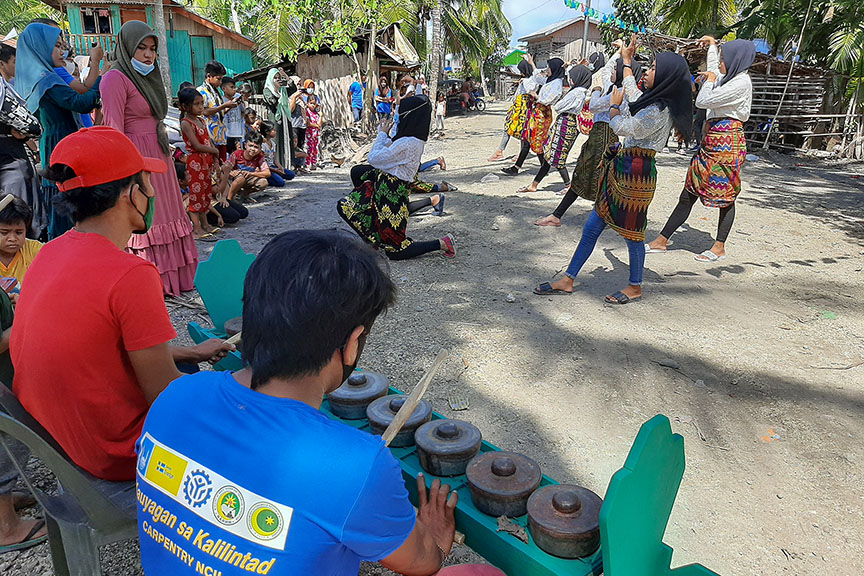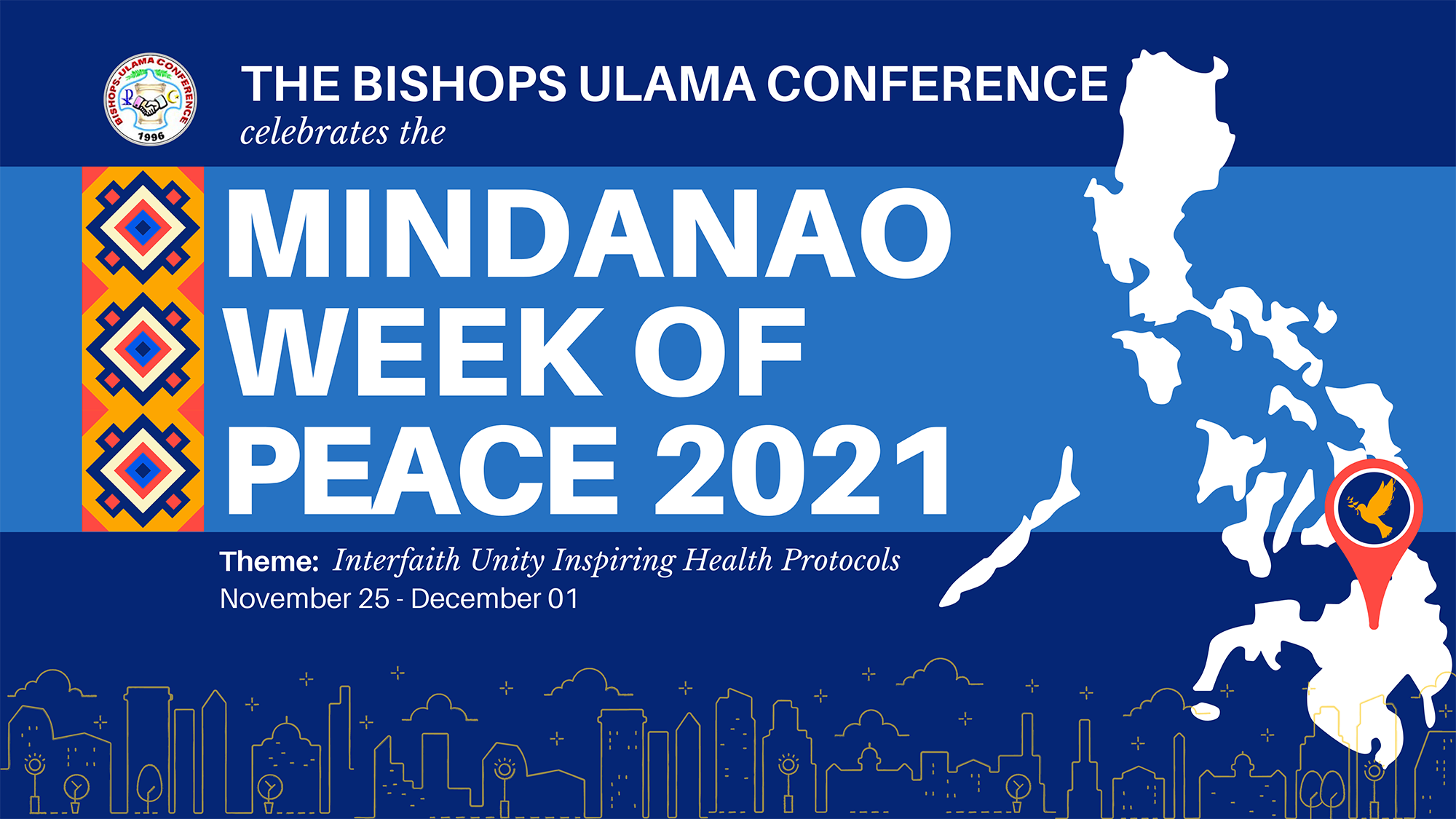From MindaNews (Nov 22, 2021): ‘Interfaith Unity Inspiring Health Protocols’ is Mindanao Week of Peace theme

WEEK OF PEACE. Led by youth leaders, the Mindanao Week of Peace celebration reaches Barangay Magaslong in conflict-affected Datu Piang municipality in Maguindanao on Monday 30 November 2020). Cultural performances coupled with a community dialogue on early and forced child marriage highlighted the celebration. MindaNews photo by JULES L. BENITEZ
This year’s theme for the Mindanao Week of Peace (MWOP) on November 25 to December 1 is “Interfaith Unity Inspiring Health Protocols.”
This is the 23rd annual celebration of the MWOP since 1999.
A Joint Statement from the Bishops – Ulama Conference (BUC) said the theme chosen for this year, the second year of the COVID-19 pandemic, is “extremely important and necessary.”
The statement noted that “all Filipinos are believers in One God” whom they call by various names such as Ginoong Dios, Magbabaya, Diwata, Allah, and in Mindanao, which is a melting pot of cultures, has various ways of responding to protocols, too.
“These different ways are oftentimes inspired by their religious beliefs. The positive aspects of these native beliefs inspire their respect and following of the health protocols,” the BUC said, adding that “directives and guidelines, ambitiously termed protocols, demand willing obedience and support to avoid becoming carriers of the dangerous COVID-19. The result is saving lives and promoting health, which are social and religious values.”
The statement was signed by the convenors from Davao City’s Archbishop Emeritus Fernando Capalla, Judge Abu-ali Cali of the Ulama League of the Philippines and Bishop Emeritus Hilario M. Gomez of the United Church of Christ of the Philippines.

Held every last Thursday of November until the first Wednesday of December, the MWOP was initiated in 1999 by the BUC (then Bishops-Ulama Forum), inspired by the annual week of peace initiated by the Peace Advocates Zamboanga (PAZ) in Zamboanga City .
The BUC was born three years earlier, on November 29, 1996.
President Joseph Estrada issued Proclamation 207 on November 5, 1999, declaring November 25 to December 1, 1999, “and every year thereafter” as the Mindanao Week of Peace, “to provide a venue for the expression in various forms of the peace aspirations of the people of Mindanao and for convergence of peace initiatives.”
The Proclamation said all concerned government agencies and instrumentalities, including government-owned and controlled corporations and members of the private sector and civil society based in Mindanao “are enjoined and encouraged to engage in relevant and meaningful activities in celebration” of the MWOP in coordination with the BUF (now BUC).
It also said the Office of the Presidential Adviser on the Peace Process (OPAPP), in partnership with the secretariat of the BUC Secretariat, “shall provide all the necessary help to ensure a successful coordination of all undertakings during the said week of peace.”
In March 2000, four months after issuing Proclamation 207, Estrada waged an “all-out war” against the Moro Islamic Liberation Front (MILF), displacing nearly a million residents, some of whom returned home only after Estrada was ousted in January 2001.
On November 3, 2000, Estrada issued Proclamation 408, amending Proclamation 207 by resetting the date of the MWOP to the last Thursday of November until the first Wednesday of December of every year thereafter.
On November 26, 2001, President Gloria Macapagal-Arroyo, who assumed the Presidency in January that year following the impeachment of Estrada, issued Proclamation 127, reiterating Proclamation 207 and declaring the last Thursday of November up to the first Wednesday of December of every year thereafter as the Mindanao Week of Peace.
MindaNews tracked down the themes of the annual celebration, many of them recurring:
1999: Healing the Past, Building the Future
2000: Mindanaoans Journeying Together Towards a Culture of Peace.
2001: Peace: Sharing the Vision of Unity and Hope
2002: Peace through Reconciliation: Mindanaoans seeking a Common Ground
2003: Healing through Forgiveness: Key to Total Human Development
2004: A Reconciled Family, Agent of Reconciliation
2005: Millennium Development Goals: Women and Youth as Partners in Peace Building
2006: In the Name of the Almighty, God of Harmony, Care for the Earth
2007: Building Bridges of Peace with our Peace Officers
2008: Integrity of Mind and Heart a Way to Reconciliation and Peace!
2009: Think Mindanao, Feel Mindanao, Bring Peace to Mindanao
2010: Responsive and Responsible Governance: Key to Peace, Development and Sustainability
2011: Common Word Between Us and You: Love of God, Love of Neighbor
2012: Love of God and Love of Neighbor, A Challenge for Mindanao
2013: Dialogue and Hope: Key to Peace
2014: We Pray for Long-lasting Peace in Mindanao. Give, Share, Live and Proclaim Peace
2015: Mindanaons’ Aspiration for Peace
2016: Healing for Personal and Social Transformation
2017: Owning Mindanao History for Peace and Development
2018: Peace Through Dialogue: Our destiny
2019: Towards Human Fraternity for Peace in Mindanao
2020: Dialogue Towards Harmony
The 27-province, 33-city Mindanao has a mixed population of original occupants – the Moro and Lumads (Indigenous Peoples) – and settlers from the Visayas and Luzon. (MindaNews)
This year’s theme for the Mindanao Week of Peace (MWOP) on November 25 to December 1 is “Interfaith Unity Inspiring Health Protocols.”
This is the 23rd annual celebration of the MWOP since 1999.
A Joint Statement from the Bishops – Ulama Conference (BUC) said the theme chosen for this year, the second year of the COVID-19 pandemic, is “extremely important and necessary.”
The statement noted that “all Filipinos are believers in One God” whom they call by various names such as Ginoong Dios, Magbabaya, Diwata, Allah, and in Mindanao, which is a melting pot of cultures, has various ways of responding to protocols, too.
“These different ways are oftentimes inspired by their religious beliefs. The positive aspects of these native beliefs inspire their respect and following of the health protocols,” the BUC said, adding that “directives and guidelines, ambitiously termed protocols, demand willing obedience and support to avoid becoming carriers of the dangerous COVID-19. The result is saving lives and promoting health, which are social and religious values.”
The statement was signed by the convenors from Davao City’s Archbishop Emeritus Fernando Capalla, Judge Abu-ali Cali of the Ulama League of the Philippines and Bishop Emeritus Hilario M. Gomez of the United Church of Christ of the Philippines.

Held every last Thursday of November until the first Wednesday of December, the MWOP was initiated in 1999 by the BUC (then Bishops-Ulama Forum), inspired by the annual week of peace initiated by the Peace Advocates Zamboanga (PAZ) in Zamboanga City .
The BUC was born three years earlier, on November 29, 1996.
President Joseph Estrada issued Proclamation 207 on November 5, 1999, declaring November 25 to December 1, 1999, “and every year thereafter” as the Mindanao Week of Peace, “to provide a venue for the expression in various forms of the peace aspirations of the people of Mindanao and for convergence of peace initiatives.”
The Proclamation said all concerned government agencies and instrumentalities, including government-owned and controlled corporations and members of the private sector and civil society based in Mindanao “are enjoined and encouraged to engage in relevant and meaningful activities in celebration” of the MWOP in coordination with the BUF (now BUC).
It also said the Office of the Presidential Adviser on the Peace Process (OPAPP), in partnership with the secretariat of the BUC Secretariat, “shall provide all the necessary help to ensure a successful coordination of all undertakings during the said week of peace.”
In March 2000, four months after issuing Proclamation 207, Estrada waged an “all-out war” against the Moro Islamic Liberation Front (MILF), displacing nearly a million residents, some of whom returned home only after Estrada was ousted in January 2001.
On November 3, 2000, Estrada issued Proclamation 408, amending Proclamation 207 by resetting the date of the MWOP to the last Thursday of November until the first Wednesday of December of every year thereafter.
On November 26, 2001, President Gloria Macapagal-Arroyo, who assumed the Presidency in January that year following the impeachment of Estrada, issued Proclamation 127, reiterating Proclamation 207 and declaring the last Thursday of November up to the first Wednesday of December of every year thereafter as the Mindanao Week of Peace.
MindaNews tracked down the themes of the annual celebration, many of them recurring:
1999: Healing the Past, Building the Future
2000: Mindanaoans Journeying Together Towards a Culture of Peace.
2001: Peace: Sharing the Vision of Unity and Hope
2002: Peace through Reconciliation: Mindanaoans seeking a Common Ground
2003: Healing through Forgiveness: Key to Total Human Development
2004: A Reconciled Family, Agent of Reconciliation
2005: Millennium Development Goals: Women and Youth as Partners in Peace Building
2006: In the Name of the Almighty, God of Harmony, Care for the Earth
2007: Building Bridges of Peace with our Peace Officers
2008: Integrity of Mind and Heart a Way to Reconciliation and Peace!
2009: Think Mindanao, Feel Mindanao, Bring Peace to Mindanao
2010: Responsive and Responsible Governance: Key to Peace, Development and Sustainability
2011: Common Word Between Us and You: Love of God, Love of Neighbor
2012: Love of God and Love of Neighbor, A Challenge for Mindanao
2013: Dialogue and Hope: Key to Peace
2014: We Pray for Long-lasting Peace in Mindanao. Give, Share, Live and Proclaim Peace
2015: Mindanaons’ Aspiration for Peace
2016: Healing for Personal and Social Transformation
2017: Owning Mindanao History for Peace and Development
2018: Peace Through Dialogue: Our destiny
2019: Towards Human Fraternity for Peace in Mindanao
2020: Dialogue Towards Harmony
The 27-province, 33-city Mindanao has a mixed population of original occupants – the Moro and Lumads (Indigenous Peoples) – and settlers from the Visayas and Luzon. (MindaNews)
https://www.mindanews.com/top-stories/2021/11/interfaith-unity-inspiring-health-protocols-is-mindanao-week-of-peace-theme/

No comments:
Post a Comment
Note: Only a member of this blog may post a comment.